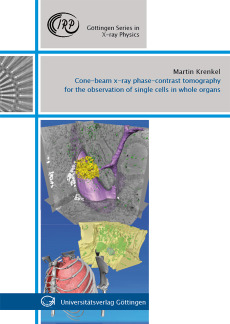Martin Krenkel
Cone-beam x-ray phase-contrast tomography for the observation of single cells in whole organs
Reihe: Göttingen Series in X-ray PhysicsX-ray imaging enables the nondestructive investigation of interior structures in otherwise opaque samples. In particular the use of computed tomography (CT) allows for arbitrary virtual slices through the object and 3D information about intricate structures can be obtained. However, when it comes to image very small structures like single cells, the classical CT approach is limited by the weak absorption of soft-tissue. The use of phase information, encoded in measureable intensity images by free-space propagation of coherent x-rays, allows a huge increase in contrast, which enables 3D reconstructions at higher resolutions. In this work the application of propagation-based phase-contrast tomography to lung tissue samples is demonstrated in close to in vivo conditions. Reconstructions of the lung structure of whole mice at down to 5 μm resolution are obtained at a selfbuilt CT setup, which is based on a liquid-metal jet x-ray source. To reach even higher resolutions, synchrotron radiation in combination with suitable holographic phase-retrieval algorithms is employed. Due to optimized cone-beam geometry, field of view and resolution can be varied over a wide range of parameters, so that information on different length scales can be achieved, covering several millimeters field of view down to a 3D resolution of 50 nm. Thus, the sub-cellular 3D imaging of single cells embedded in large pieces of tissue is enabled, which paves the way for future biomedical research.

